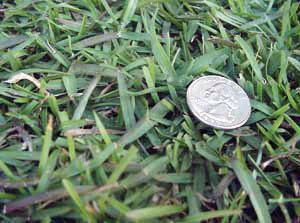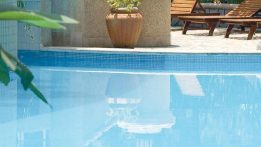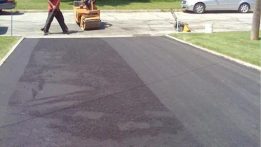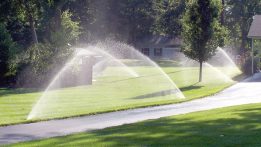 This creeping perennial is well adapted to the sandy, acidic soils of low fertility and requires low maintenance. It spreads by stolons and has a coarse texture with short upright stems that grow to about 3-5 inches and requiring less mowing, survives in mild cold temperatures as long as there aren’t several hard freezes since it doesn’t go into a true dormancy and with light freezes will turn brown but as soon as the temperature rises it will recover and re-greens.
This creeping perennial is well adapted to the sandy, acidic soils of low fertility and requires low maintenance. It spreads by stolons and has a coarse texture with short upright stems that grow to about 3-5 inches and requiring less mowing, survives in mild cold temperatures as long as there aren’t several hard freezes since it doesn’t go into a true dormancy and with light freezes will turn brown but as soon as the temperature rises it will recover and re-greens.
Established Common Centipede
Being a low growing grass it is a favorite of busy lawn growers with a much longer period of days being added to the mowing cycle. Low fertilization (with low phosphorus) requirements can be met by a yearly application. Too much nitrogen can produce growth but cause problems with insects or disease. Centipede is rather drought tolerant and when healthy is aggressive enough to choke out weeds and other grasses. In the south this grass will remain green throughout the year. Although the roots are not as deep as Bahia or Bermuda, its close to the ground growth allows for better conservation of water and helps fight drought. Slightly shade tolerant and full sun.
Centipede Planting Rates:
Plant no less than one-fourth (1/4) pound per 1,000 square. One pound of seed covers 2,000 to 4,000 square feet and often produces a good lawn in two to three months of summer growth – We recommend planting 1/2 lb. per 1000 sq. feet for best results. Centipede is slow to establish / patience is required.
Maintenance & Care
Maintenance: Centipede grass has probably the lowest maintenance of the warm season grasses. Its popularity stems from the tenacity to grow on poor, sandy soils to clay based ones.
Needing little fertilization and not needing to be mown as much makes it a preferable for busy lifestyles.
In normal average rainfall years it can do very well with just a little care. Once a year weed-n-feed program kills the few weeds that might emerge and feeds enough for the year. Or divide the requirements into seasonal fertilization schedules. The texture is said to be coarser than the so-called better grasses, but this may be due to the lack of moisture in a given season. Proper care in maintenance (mowing or watering) and this grass will compete against weeds on its own. Definitely not suited for higher traffic areas and slow to repair but I have found this grass to be a “take care of on the run grass” for busy lifestyles. As long as it doesn’t get mown too short between times.
TWO KEY MAINTENANCE SUGGESTIONS:
1) Do NOT over-fertilizer – Centipede cannot handle a lot of fertilzier.
2) Do NOT mow low – Centipede mowed lowed becomes stressed out and thuse tend to have problems or even die out.
Centipede is resistant to most disease and insects with the main problem being the build up of thatch. Early spring raking can take care of this problem easily and using a bag catcher when mowing. The main importance of getting a good lawn from centipede is to have the site as free from deviations in ground level as possible. This grass will be mown quite low and every hill or bump will result in the grass getting scalped and the roots will die and centipede does not repair quickly.
Maintenance: Low to medium with yearly fertilization and possible additions of iron sulfate or chelate on heavier soils with pH higher than 7.2 and on sandy soils higher than 6.5; regular mowing and watering when necessary. Potassium might have to be added in the spring and fall to encourage root development and help to winterize the lawn.
Watering: In the starting stages the ground should be kept moist, not soaked until established seedlings take root. Water four to eight (depending upon sandiness) inches deep at the time to establish a deeper root system because centipede is not as drought tolerant as some other grasses. Shallow watering only provides for the root system to establish just under the soil. Medium to low water usage depending upon the weather. In drought conditions water thoroughly as with all grasses.
Mowing Depends upon growth and the lawn you want to achieve. Proper mowing should be determined by
1 ½ – 2 inches.
Weeding: Early spring application of herbicides for crabgrass and annual weeds and a hormone type for broadleaf weeds.
Fertilization: Low to medium if at all with nitrogen and potassium and no phosphorus as this depletes the iron levels; a good application would be 15-0-15. 16-4-8 is also a recommended fertilizer for Centipede. Centipede is not responsive to high rates of fertilizers. Fertilizer should be added at the time of planting, with additional yearly application. Iron chlorosis can be a problem. Chelated or ferrous sulfate is recommended for improving the iron deficiency — Also balancing the pH to a more acidic level can help. It adapts best to a soil pH of 5.0 to 5.5.
Weed Control is needed in the winter to discourage weed growth while the grass is dormant in the cooler areas. Herbicides of a hormonal type can be used at this time for the broad-leafed weeds and other weeds can be controlled with pre-emergence herbicides.
Diseases that are common are brown patch and dollar spot.
Ryegrass Overseeding – Most experts recommend that you do NOT overseed your centipede lawn with a winter ryegrass. It can in some situations result in thinning out (killing) of your lawn over time due to the added stress of early spring competition. Fescue in general is a better overseed variety to use (not ryegrass). However in general the best recommendation is to do nothing.
Pests that affect Centipede include nematodes and ground pearls. Nematodes & ground pearls can usually be prevented by keeping the moisture level up since each grows well in sandier, drier areas. Your last resort will be fumigation of the soil for nematodes infestations. Nematodes are the most serious of the pest problems affecting Centipede grass. Infected areas will show heavy wilt even under good watering practices. Other insects affecting Centipede are spittlebugs, sod webworms, mole crickets, caterpillars and grubs.
Centipede decline is a problem in some centipede lawns. this occurs after a few years of an established lawn’s life and is usually indicative or some underlying problems. Symptoms are yellow spots in lawn (also caused by iron chlorosis) and dead spots in spring growth. Causes of the decline can be any one or combination of these practices or conditions:
- Excessive nitrogen applications
- High Soil pH (Greater than 6.5)
- Nematodes and other organisms.
- Excessive thatch causing cold damage to roots.





